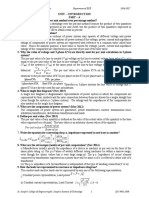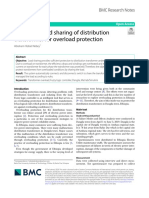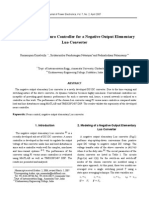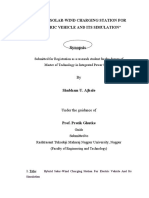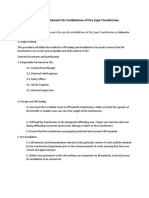Design and Simulation of A PV System With Battery Storage Using Bidirectional DC DC Converter Using Matlab Simulink
Design and Simulation of A PV System With Battery Storage Using Bidirectional DC DC Converter Using Matlab Simulink
Uploaded by
Dobrea Marius-AlexandruCopyright:
Available Formats
Design and Simulation of A PV System With Battery Storage Using Bidirectional DC DC Converter Using Matlab Simulink
Design and Simulation of A PV System With Battery Storage Using Bidirectional DC DC Converter Using Matlab Simulink
Uploaded by
Dobrea Marius-AlexandruOriginal Title
Copyright
Available Formats
Share this document
Did you find this document useful?
Is this content inappropriate?
Copyright:
Available Formats
Design and Simulation of A PV System With Battery Storage Using Bidirectional DC DC Converter Using Matlab Simulink
Design and Simulation of A PV System With Battery Storage Using Bidirectional DC DC Converter Using Matlab Simulink
Uploaded by
Dobrea Marius-AlexandruCopyright:
Available Formats
See discussions, stats, and author profiles for this publication at: https://www.researchgate.
net/publication/314719630
Modelling of a grid connected solar PV system using MATLAB/simulink
Article in International Journal of Simulation: Systems, Science & Technology · March 2017
DOI: 10.5013/IJSSST.a.17.41.45
CITATIONS READS
4 4,803
1 author:
Jawairia Atiq
Heriot-Watt University
1 PUBLICATION 4 CITATIONS
SEE PROFILE
All content following this page was uploaded by Jawairia Atiq on 12 March 2017.
The user has requested enhancement of the downloaded file.
JAWAIRIA ATIQ et al: MODELLING OF A GRID CONNECTED SOLAR PV SYSTEM USING MATLAB/SIMULINK
Modelling of a Grid Connected Solar PV System Using MATLAB/Simulink
Jawairia Atiq, Prashant Kumar Soori
Electrical and Electronics Engineering Department
Heriot Watt University, Dubai Campus
Dubai, UAE
Abstract — This paper presents an easier approach for modelling a 10.44 kW grid connected photovoltaic (PV) system using
MATLAB/Simulink. The proposed model consists of a PV array, Maximum power point tracker, Boost converter, Inverter and an
LC filter. Modelling of these components has been described and demonstrated in detail. The impact of solar irradiance and
temperature on the overall power generation of a grid connected PV system has been studied. Control to maintain constant voltage
at the inverter output and for synchronization of the output frequency with the electric utility grid, phase locked loop and
regulators have been designed and modelled. Modelling method is quite simple and can be adopted easily to study system
characteristics at different conditions of temperature and solar insolation.
Keywords - incremental conductance; inverter control; MPPT; photovoltaic; PV array.
I. INTRODUCTION II. METHODOLOGY
Most of the world’s energy is derived from fossil fuels A. PV Array
mainly by burning of coal. But this traditional way of
electricity generation is a challenging issue as it contributes A Solar cell is the basic unit of a photovoltaic (PV) system.
to greenhouse gas emissions. Besides, Fossil fuels and all Combination of solar cells in series forms a PV panel or PV
the non-renewable resources to generate electricity are also module. These modules when connected in series and
depleting with time and the population is increasing. parallel form PV arrays.
On the other hand, renewable energy resources offer Modelling of PV array has been done considering single
promising alternate solutions for these problems as they are diode of PV cell [1]. The basic diagram and the equations
believed to be permanent and clean sources. Therefore, at used for modelling a solar cell have been considered. These
present these issues are being handled by adopting equations have been modified based upon the number of
renewable resources which includes Solar photovoltaic, solar cells in PV panels and total number of these panels
wind, tidal, wave and biomass as alternate sources to connected in series and parallel.
produce electricity [1]. The circuit diagram of a single non- ideal solar cell is
From past few decades, solar photovoltaic energy has shown in Figure 1.
turned into one of the important sources of renewable
energy as it requires less maintenance and is noise and
pollution free. Solar PV panels are used with power
converters to deliver power efficiently. This forms a
photovoltaic system. There are various configurations of
PV systems. Among these standalone and grid connected
system configurations are the most important ones [1].
A grid connected solar system has more advantages than
a standalone PV system as in it electricity can be taken or
send to the electric grid depending upon the load demand. It Figure 1. Single diode model of PV cell.
reduces bill cost as net electricity consumption can be
reduced by sending extra electricity to the grid. They can From the Figure1 current equation can be written as
also be installed without battery backup. Any photovoltaic
system installed without battery backups produces more I = Ipv – ID – Ish (1)
power as no storage losses are involved in the system [2].
In this paper, a 10.44 kW grid connected PV system has Where, I is the current generated by a solar cell, Ipv is the
been modeled using MATLAB /Simulink. The presented photon current, ID is the diode current and Ish is the current
system is composed of a solar PV array, maximum power
flow through shunt resistor Rp.
point tracker to extract maximum power from the PV array,
DC-DC boost converter to regulate and boost the PV array For a solar cell[1]:
output, an inverter to convert DC power into AC power, an
LC filter to filter current harmonics from the inverter output
current.
DOI 10.5013/IJSSST.a.17.41.45 45.1 ISSN: 1473-804x online, 1473-8031 print
JAWAIRIA ATIQ et al: MODELLING OF A GRID CONNECTED SOLAR PV SYSTEM USING MATLAB/SIMULINK
At this point when equation (9) is satisfied, Rs and Rp are
determined. P_max┬calculated is given by [4]
Equation (1) can now be written as
Where, I_ois the reverse saturation current, R_s and R_p From (9) and (10)
are the series and shunt resistance of a PV cell respectively,
a is diode ideality factor, V_th is the thermal voltage. It is
given as:
Rearranging equation (11)
K is Boltzmann constant =1.38×〖10〗^(-23) J/K, T is the
cell temperature, q is the charge of an electron
=1.6×〖10〗^(-19) C.
Knowing the total number of series connected solar cells These values are calculated for standard conditions of
N that result in a solar panel/module and from the numbers temperature and solar insolation which are 25°C and 1
of series Ns and parallel Np connected solar panels, Current kW/m². R_sand〖 R〗_p at any temperature has same value
equation for a PV array is given by: as at standard temperature. For PV array,
1) Parameters Extraction Method:
For modelling a PV array, all parameters in equation (6)
should be known. But, Solar PV panels datasheets do not
contain values of all of these parameters. This section
highlights more on these parameters value determination.
The diode ideality factor (a) and Energy gap (Eg) values for
a solar cell does not need to be extracted using any method
or equation as these parameters depend upon the material
from which solar PV cell is made of [3]. Since Sunpower’s
panels that have been used in modelling in this papers are
made using mono-crystalline silicon so, a and E_g values
for mono-crystalline silicon which are 1.2 and 1.12
respectively, were used. At reference temperature (T_ref =
298.15 K), photon current is given by [4]:
Rs and Rp at reference temperature are found using the
approach shown in Figure 2. Power at maximum power
point is found using:
The algorithm takes datasheet values and the required Figure 2. Iterative programming approach to find Rs and Rp values.
constant values as inputs. Using these inputs maximum
value of Rs and minimum value of Rp is found. Initial value
of Rs is set as 0. Algorithm increments the value of Rs 2) Modelling of PV array:
until:
10.44kW PV array has been modelled using 24 sun power
(SPR-435NE-WHT-D) 435 W panels. The datasheet values
for this panel are shown in Figure 3.The parameter values
DOI 10.5013/IJSSST.a.17.41.45 45.2 ISSN: 1473-804x online, 1473-8031 print
JAWAIRIA ATIQ et al: MODELLING OF A GRID CONNECTED SOLAR PV SYSTEM USING MATLAB/SIMULINK
from datasheet and those determined using the procedure
described in parameter extraction section has been used in
the PV array model
Modelling of reverse saturation current at reference is
shown in Figure5.
Figure 5. - Modeling of Reverse saturation current at reference
temperature.
At different conditions of temperature, the reverse
saturation current is determined using [4]:
Where, 〖I_( o)〗_n is Reverse saturation current at standard
temperature, E_gis energy gap value = 1.12 (for mono-
crystalline silicon). Modeling of this current is shown in
Figure6.
Figure 3. SPR-435NE-WHT-D module datasheet values [5].
Current based model of PV array has been modelled
using the following subsystem models:
Photon current: Photon current has been modelled using
[3]:
Where, Iph_nis the photon current value at reference
conditions, KI is the current temperature coefficient, T_refis
reference temperature = 273.19K, T is the cell temperature,
G is the irradiance value and G_nis the irradiance value at Figure 6. Reverse saturation current modeling.
standard temperature. Photon current modelling is shown in
Figure4. Current through diode in PV array model using reverse
saturation current is given by [4]:
Diode current modelling is shown in Figure7.
Figure 4. Photon current modeling.
3) Diode current: Diode current at any temperature takes
reverse saturation current into account. Reverse saturation
current at standard condition is found by [4]
DOI 10.5013/IJSSST.a.17.41.45 45.3 ISSN: 1473-804x online, 1473-8031 print
JAWAIRIA ATIQ et al: MODELLING OF A GRID CONNECTED SOLAR PV SYSTEM USING MATLAB/SIMULINK
is set based upon the requirement at the output of the DC-
DC boost converter.
Modeling of MPPT is shown in Figure 9.
Figure 7. Modelling of Diode current.
4) Complete modelling of PV array: The output current
from PV array can be modelled using equation (6). The
complete modelling of PV array has been depicted in Figure Figure 9. Maximum power point tracking using incremental conductance
8. with internal regulator.
C. Boost Converter
A DC-DC boost converter is used to boost and regulate the
output voltage of the PV array and to implement Maximum
power point tracking. The modelled boost converter circuit
is shown in the Figure 10.
The converter output is given by:
Inductor and capacitor in the circuit were selected using the
following equations.
Figure 8. Complete PV array modeling.
B. Maximum Power Point Tracking (MPPT)
The solar PV array has a nonlinear behaviour and its Where in these equations, V_o is the output voltage,V_in is
output changes repeatedly due to change in weather input voltage, D is the duty cycle value, f is the converter
conditions. MPP tracker helps the PV array to deliver frequency, ∆I is the current ripple,C_1 and C_2are the
maximum power at its output and thus increases the system capacitors capacitances, ∆V_out is the output voltage ripple
efficiency. It sets a suitable duty cycle value at the gate of and R_(load )is the load resistance given by V_out/I_out.
Insulated-gate bipolar transistor (IGBT) switch used in
boost converter so that maximum power can be extracted.
Incremental conductance technique with internal regulator
has been used to model MPPT. At maximum power point :
Now,
Figure 10. DC to DC boost converter modeling.
MPPT tests for (dI )/dV and I/V to be zero. If the sum is not
zero, PI controller/regulator treats the sum as error and D. DC to AC Converter:
minimizes this error. The obtained value at the output of the
PI controller is the change in duty cycle value. This is Three-phase three level voltage source converter has
added to the initial value of duty cycle (D). Initial D value been used to convert DC power into AC. Simulink block
used for this purpose is shown in Figure 11.
DOI 10.5013/IJSSST.a.17.41.45 45.4 ISSN: 1473-804x online, 1473-8031 print
JAWAIRIA ATIQ et al: MODELLING OF A GRID CONNECTED SOLAR PV SYSTEM USING MATLAB/SIMULINK
Capacitors at the output of boost converter provide neutral
point N for the inverter. Gate signals at the inverter controls
the IGBT switches on and off period. These signals are
generated by inverter control loop.
Designed inverter control loop consists of
Phase locked loop (PLL) and dq0 transformer
DC voltage control loop
Current control loop
Reference voltage and PWM generator
Figure 13. - Phase locked loop and dq0 transformation.
2) DC voltage control loop:This loop regulates the DC
voltage at the input of the inverter. PI controller gains were
selected using the formulas [7] :
Figure 11. Simulink three phase Voltage source inverter bridge block.
Inputs to the control loop are the three-phase grid voltage Where, K_p and K_I are the proportional and integral
and currents. Complete inverter control loop is shown in the gains of the PI controller,C is the boost converter capacitor
Figure 12. value and T_s is the switch period of the inverter switches.
DC voltage regulator is shown in Figure14.
Figure 14. Input DC voltage regulator.
3) Current control loop: This loop regulates current in dq0
reference frame. The loop is shown in the Figure15.
Figure 12. Inverter control loop modeling.
The output from the inverter control loop is the
controlled PWM signals. These signals control the
switching on and off of IGBT switches in inverter. Inverter
generates three phase sinusoidal voltage and currents.
1) Phase locked loop (PLL) and dq0 transformer: This
section in the inverter control converts the voltage and
currents to per unit values. PLL takes the grid voltage and
finds its angle and frequency. This plays an important role
in making inverter output and grid angles equal. dq0
transformer converts three phase voltages and currents from
abc to dq0 reference frame. Conversion into dq0 frame
provides accurate control for the signals. The modelled PLL
and dq0 transformer block is shown in the Figure13.
Figure 15. Current control loop modeling.
DOI 10.5013/IJSSST.a.17.41.45 45.5 ISSN: 1473-804x online, 1473-8031 print
JAWAIRIA ATIQ et al: MODELLING OF A GRID CONNECTED SOLAR PV SYSTEM USING MATLAB/SIMULINK
frequency of the filter. Suitable inductor and capacitor
PI controller gains were selected using [7]: values are selected using
(26)
(28)
(27)
Where L is inductor inductance and C is capacitor
Where, L is the LC filter inductor value, T_s is the Inverter capacitance.
switching period, τ is the time constant given by L/R, Complete grid connected system is shown in the Figure16.
Where R is the Filter resistance = 1 Ω.
Reference voltage and PWM generator: This section
converts the voltage back into abc reference frame from dq0 III. SIMULATION AND RESULTS
frame. Pulse width modulator (PWM generator generates
PWM signals by the comparison of the three phase The designed grid connected system was tested with
reference signals and the triangular wave with the particular three phase 2.75 kW load. The generated PV array power,
frequency. Selected frequency for PWM generator is the power available at the inverter output and that flowing
1975Hz. to and from the grid was observed with varying solar
insulation and temperature values. PV array power, Boost
-E. LC filter: converter output, Inverter and the grid powers under
different temperatures and solar insulations are shown in
LC filter at the output of the inverter is used to reduce Figure17 to Figure20.
inverter current harmonics. 50 Hz was selected as cut off
Figure 16. Complete modelled grid connected PV system.
Figure 18. DC voltage at boost converter output.
Figure 17. Input solar irradiance in kW/m² and temperature to the system
and generated power by PV array.
DOI 10.5013/IJSSST.a.17.41.45 45.6 ISSN: 1473-804x online, 1473-8031 print
JAWAIRIA ATIQ et al: MODELLING OF A GRID CONNECTED SOLAR PV SYSTEM USING MATLAB/SIMULINK
PV array modeling using datasheet values was
presented. To maximize the output power of PV array,
incremental conductance with internal regulator technique
was used along with the DC-DC boost converter. A DC to
AC PV inverter along with an LC filter was designed to
convert DC voltage and current to AC values. Controlled
SPWM modulation technique to generate reference signals
for inverter IGBT switches has been utilized.
For testing, System was simulated under varying
temperature and solar insolation values. It was observed
Figure 19. AC Power generated by PV inverter. that the system output power is more affected by solar
irradiance than with varying temperature. The presented
model can be used to study system output characteristics at
any condition of temperature and solar irradiance.
REFERENCES
[1] Rauschenbach, H.S. Solar Cell Array Design Handbook. The
Principles And Technology Of Photovoltaic Energy Conversion.
New York, N.Y.: Van Nostrand Reinhold,1980, 1980. Print.
[2] ”A New Approach to Design of an optimized Grid Tied Smart Solar
Figure 20. Power supplied or taken from electric utility grid. Photovoltaic (PV) System”. International Journal of Advancements
in Research & Technology, Volume 1, Issue6, ISSN 2278-7763,
November-2012.
From the simulation results shown above, it can be seen [3] Chedid, R.; Tajeddine, R.; Chaaban, F.; Ghajar, R., "Modeling and
simulation of PV arrays under varying conditions,"in
that change in solar irradiance affects power generation MediterraneanElectrotechnical Conference (MELECON), 2014 17th
more than the change of temperature. Initially at high IEEE , vol., no., pp.536-542
irradiances, inverter output is more than the load demand [4] M. G. Villalva, J. R. Gazoli and E. R. Filho, "Comprehensive
and hence power flows from the system to the grid. This is Approach to Modeling and Simulation of Photovoltaic Arrays," in
shown in grid power graph (Figure 20). On the other hand, IEEE Transactions on Power Electronics, vol. 24, no. 5, pp. 1198-
1208
at zero or very low the irradiance, Inverter output power is [5] Sunpower Corporation, "SUNPOWER E20/435 SOLAR PANEL",
less than the requirement and therefore, the grid supplies SUNPOWER, 2011. [Online].
the power. This is shown as negative power in the same Available:http://us.sunpower.com/sites/sunpower/files/media-
graph. Negative power shows the supplying of power from library/data-sheets/ds-e20-series-435-solar-panel-datasheet.pdf.
[Accessed: 04- Feb- 2016].
the grid whereas positive power indicates sending of power [6] Gow, J.A.; Manning, C.D., "Development of a photovoltaic array
to the grid from the PV system. model for use in power-electronics simulation studies," in Electric
Power Applications, IEE Proceedings - , vol.146, no.2, pp.193-200
[7] L. Ma, W. Ran and T. Q. Zheng, "Modeling and control of three-
IV. CONCLUSION phase grid-connected photovoltaic inverter," Control and
Automation (ICCA), 2010 8th IEEE International Conference on,
Xiamen, 2010, pp. 2240-2245.
The paper proposed the modeling a grid connected PV [8] M. G. Villalva, J. R. Gazoli and E. R. Filho, "Modeling and control
system. The detailed modeling of the components that are of a three-phase isolated grid-connected converter fed by a
used in the system has been described in detail. photovoltaic array," Power Electronics Conference, 2009.COBEP
'09. Brazilian, Bonito-Mato Grosso do Sul,
2009, pp. 202-210.
DOI 10.5013/IJSSST.a.17.41.45 45.7 ISSN: 1473-804x online, 1473-8031 print
View publication stats
You might also like
- Carleton University: Name: Signature: Student #Document7 pagesCarleton University: Name: Signature: Student #umangdoshiNo ratings yet
- FYP 1 PresentationDocument15 pagesFYP 1 PresentationEngr Majid Ali BaigNo ratings yet
- DC Motor Speed ...Document68 pagesDC Motor Speed ...Yousif nasir100% (1)
- Pe Final Ex SS 2010-2011Document8 pagesPe Final Ex SS 2010-2011Saif Uddin100% (1)
- Implementation of Standalone Hybrid Power System Using Matlab/simulinkDocument6 pagesImplementation of Standalone Hybrid Power System Using Matlab/simulinkIJIERT-International Journal of Innovations in Engineering Research and TechnologyNo ratings yet
- Power System Simulation Lab ManualDocument41 pagesPower System Simulation Lab Manualgokulchandru100% (1)
- SPWM Inverter DownloadDocument2 pagesSPWM Inverter DownloadSebastian ArboledaNo ratings yet
- Generation With Limited Energy SupplyDocument34 pagesGeneration With Limited Energy SupplySyed Ali RazaNo ratings yet
- Economic Dispatch by Equal Incremental Cost Criterion PDFDocument4 pagesEconomic Dispatch by Equal Incremental Cost Criterion PDFdubuli123100% (1)
- Psa QB 2016-2017 Questions OnlyDocument25 pagesPsa QB 2016-2017 Questions OnlykmohanadasseNo ratings yet
- PV MPPT PoDocument26 pagesPV MPPT PoBaidyanath JenaNo ratings yet
- DC Micro Grid For Wind and Solar Power Integration: A Project ReportDocument58 pagesDC Micro Grid For Wind and Solar Power Integration: A Project ReportVinayaga ProjectinstituteNo ratings yet
- Chapter OneDocument28 pagesChapter Oneadisu100% (2)
- Hydro Thermal Economic Dispatch With Renewable EnergyDocument75 pagesHydro Thermal Economic Dispatch With Renewable EnergyMohandRahimNo ratings yet
- Pi Voltage Control Technique For 3 Phase Induuction Motor Using Simulink and ArduinoDocument37 pagesPi Voltage Control Technique For 3 Phase Induuction Motor Using Simulink and ArduinoPFANo ratings yet
- Seminar Report Light Emitting PolymerDocument39 pagesSeminar Report Light Emitting PolymerarattupuzhaNo ratings yet
- Fuse Saving Blowing SchemesDocument2 pagesFuse Saving Blowing SchemesReza TorkamanNo ratings yet
- Automatic Power Factor Controller Using MicrocontrollerDocument29 pagesAutomatic Power Factor Controller Using Microcontrollervallery1100% (3)
- Power System Simulation - Prof - Jain B. Marshel - ScilabDocument72 pagesPower System Simulation - Prof - Jain B. Marshel - ScilabJerry ValdezNo ratings yet
- Inverters On Power Electronics Related Questions and AnswersDocument2 pagesInverters On Power Electronics Related Questions and AnswersGuna PriyaNo ratings yet
- Python Scripting For Digsilent Powerfactory: Leveraging The Python Api For Scenario Manipulation and Analysis of Large DatasetsDocument30 pagesPython Scripting For Digsilent Powerfactory: Leveraging The Python Api For Scenario Manipulation and Analysis of Large DatasetsPaul CorellaNo ratings yet
- 17EEL76 - PSS Lab ManualDocument31 pages17EEL76 - PSS Lab ManualnfjnzjkngjsrNo ratings yet
- Semi ConverterDocument11 pagesSemi ConverterSatyashoka SatyashokaNo ratings yet
- Modeling and Control of Isolated Micro-Hydro Power Plant With Battery Storage SystemDocument7 pagesModeling and Control of Isolated Micro-Hydro Power Plant With Battery Storage SystemZainal Arif RochimNo ratings yet
- IOT Based Deliberate Load Shedding Management System: Project Report OnDocument34 pagesIOT Based Deliberate Load Shedding Management System: Project Report OnAdhiraj KakatiNo ratings yet
- MPPT PresentationDocument20 pagesMPPT Presentationworldcreators2_79758No ratings yet
- 351 - 27435 - EE419 - 2016 - 1 - 2 - 1 - 0 3 EE419 Lec6,7 Compensation RLDocument47 pages351 - 27435 - EE419 - 2016 - 1 - 2 - 1 - 0 3 EE419 Lec6,7 Compensation RLtsegayNo ratings yet
- 10 - New MPPT Algorithm Based On PIC Microcontroller - 2016Document15 pages10 - New MPPT Algorithm Based On PIC Microcontroller - 2016Ammar Al-KindyNo ratings yet
- Load Flow AnalysisDocument35 pagesLoad Flow AnalysisSachinNo ratings yet
- Unified Power Flow Controller (UPFC)Document27 pagesUnified Power Flow Controller (UPFC)mksamy2021No ratings yet
- Buck ConvertersDocument15 pagesBuck Convertersmuddassir07100% (2)
- Last PDF of Project ReportDocument18 pagesLast PDF of Project ReportRAVINA MANGAL100% (1)
- Problems - 17EE81 - Module-4 - AGC and AGC in Interconnected Power System-Problems - R.GunasekariDocument16 pagesProblems - 17EE81 - Module-4 - AGC and AGC in Interconnected Power System-Problems - R.GunasekariManoj ManuNo ratings yet
- Automatic Load Shedding Using GSMDocument2 pagesAutomatic Load Shedding Using GSMPrayog TechNo ratings yet
- SojitsDocument12 pagesSojitskavish malakaNo ratings yet
- Pic ProjectsDocument6 pagesPic ProjectsAmr GhonemNo ratings yet
- Automatic Load Sharing of Distribution TransformerDocument6 pagesAutomatic Load Sharing of Distribution TransformerNimona NigussieNo ratings yet
- Luo ConverterDocument6 pagesLuo ConverterAndrei CocorNo ratings yet
- Digsilent Powerfactory: Technical Reference DocumentationDocument26 pagesDigsilent Powerfactory: Technical Reference DocumentationROYNo ratings yet
- MPPT Project ReportDocument14 pagesMPPT Project ReportJackNo ratings yet
- Design and Implementation of Various MPPT Algorithms For Solar Charge Controller To Improve The Efficiency Using PSIMDocument54 pagesDesign and Implementation of Various MPPT Algorithms For Solar Charge Controller To Improve The Efficiency Using PSIMaarumugam_rajendran100% (6)
- Microcontroller Based Three Phase InverterDocument4 pagesMicrocontroller Based Three Phase InverterEditor IJRITCCNo ratings yet
- Computer Techniques in Power System Analysis NotesDocument60 pagesComputer Techniques in Power System Analysis Notesdivya1587No ratings yet
- Determination of Critical Clearing Time in Transient Stability AnalysisDocument5 pagesDetermination of Critical Clearing Time in Transient Stability Analysisblue_sea_00No ratings yet
- Expt 3 - EEM - Dielectric Strength of Liquid Insulating MaterialDocument6 pagesExpt 3 - EEM - Dielectric Strength of Liquid Insulating MaterialAvaniPujaraNo ratings yet
- Design and Implementation of A Solar Integration IDocument7 pagesDesign and Implementation of A Solar Integration IAmir KalčoNo ratings yet
- PSOC Assignment-1 I. Short Answer QuestionsDocument3 pagesPSOC Assignment-1 I. Short Answer Questionssurisetti amruthaNo ratings yet
- PID Thesis Book PDFDocument58 pagesPID Thesis Book PDFMainul BaikkaNo ratings yet
- Hirth 2013 Market Value Renewables Solar Wind Power Variability PriceDocument45 pagesHirth 2013 Market Value Renewables Solar Wind Power Variability PriceAyoub EnergieNo ratings yet
- DDocument2 pagesDRaj Kamal0% (2)
- Power System Dynamics and ControlDocument2 pagesPower System Dynamics and ControlSudip MondalNo ratings yet
- Lec 1 Unit 3 NasDocument21 pagesLec 1 Unit 3 NasRIYA SHARMANo ratings yet
- Modelling of Grid-Connected Geared 2MW PMSG Wind Turbine GeneratorDocument88 pagesModelling of Grid-Connected Geared 2MW PMSG Wind Turbine GeneratorDao Van ManhNo ratings yet
- Synopsis: "Hybrid Solar-Wind Charging Station For Electric Vehicle and Its Simulation"Document9 pagesSynopsis: "Hybrid Solar-Wind Charging Station For Electric Vehicle and Its Simulation"Mahesh ShendeNo ratings yet
- Modeling and Simulation of Grid-Connected Hybrid Photovoltaic/Battery Distributed Generation SystemDocument10 pagesModeling and Simulation of Grid-Connected Hybrid Photovoltaic/Battery Distributed Generation SystemBreno NunesNo ratings yet
- A Step by Step Technique For Using SimulDocument10 pagesA Step by Step Technique For Using SimulhajasoftwareNo ratings yet
- 3.1-Study On Temperature For Modeling of PV Array Using TEST DATA PDFDocument4 pages3.1-Study On Temperature For Modeling of PV Array Using TEST DATA PDFRUBIONo ratings yet
- (ART) A Photovoltaic System Model For Matlab Simulink PDFDocument5 pages(ART) A Photovoltaic System Model For Matlab Simulink PDFMustapha El MetouiNo ratings yet
- International Journal of Engineering Research and DevelopmentDocument8 pagesInternational Journal of Engineering Research and DevelopmentIJERDNo ratings yet
- Design and Simulation of A PV System With Battery Storage Using Bidirectional DC DC Converter Using Matlab Simulink PDFDocument8 pagesDesign and Simulation of A PV System With Battery Storage Using Bidirectional DC DC Converter Using Matlab Simulink PDFDobrea Marius-AlexandruNo ratings yet
- AP L5tDocument29 pagesAP L5tDobrea Marius-AlexandruNo ratings yet
- REC N Peak Solar Panel DatasheetDocument2 pagesREC N Peak Solar Panel DatasheetDobrea Marius-AlexandruNo ratings yet
- Design and Simulation of A PV System With Battery Storage Using Bidirectional DC DC Converter Using Matlab Simulink PDFDocument8 pagesDesign and Simulation of A PV System With Battery Storage Using Bidirectional DC DC Converter Using Matlab Simulink PDFDobrea Marius-AlexandruNo ratings yet
- Manual Power-Meter A3 en 2.0.0Document2 pagesManual Power-Meter A3 en 2.0.0Dobrea Marius-AlexandruNo ratings yet
- addUPI 1.2.2Document57 pagesaddUPI 1.2.2Dobrea Marius-AlexandruNo ratings yet
- The Big Issue 13.05.2024 - Freemagazines - TopDocument48 pagesThe Big Issue 13.05.2024 - Freemagazines - Topfree magazinesNo ratings yet
- ANH VAN CHUYASN NGANH ANH TrangDocument58 pagesANH VAN CHUYASN NGANH ANH Trangqce54185No ratings yet
- Piston Engine Tutorial Questions 2010Document19 pagesPiston Engine Tutorial Questions 2010Joseph Timoney100% (5)
- Accessory ch01 Data Sheet Eng - AshxDocument4 pagesAccessory ch01 Data Sheet Eng - AshxPetru StancuNo ratings yet
- Eurotherm 3200series Controllers Datasheet PDFDocument6 pagesEurotherm 3200series Controllers Datasheet PDFefasaravananNo ratings yet
- SMK Bandar Bintulu Chemistry 962 Semester 1 2016: Answer All Questions in This SectionDocument9 pagesSMK Bandar Bintulu Chemistry 962 Semester 1 2016: Answer All Questions in This Sectiontang ka ongNo ratings yet
- Evs Revised Syllabus & BooksDocument10 pagesEvs Revised Syllabus & BooksprashantNo ratings yet
- Gebart0615e UsDocument2 pagesGebart0615e UsSahilNo ratings yet
- B tech-CSE PDFDocument183 pagesB tech-CSE PDFkunal yadavNo ratings yet
- Camsco E Catalog PDFDocument384 pagesCamsco E Catalog PDFKelvyn Raqui100% (1)
- EN 1991-1-4 NA enDocument4 pagesEN 1991-1-4 NA enanuj3936100% (1)
- Tutorial 5B: Tutorial Tahap Clo-PloDocument13 pagesTutorial 5B: Tutorial Tahap Clo-PloZariff ZakiNo ratings yet
- TEST REPORT - GPO-3 WhiteDocument1 pageTEST REPORT - GPO-3 WhitetanniayulianaNo ratings yet
- Why Do You Need An Air Receiver?Document21 pagesWhy Do You Need An Air Receiver?Himanshi SharmaNo ratings yet
- Material 1.2738 - 40CrMnNiMo8-6-4Document1 pageMaterial 1.2738 - 40CrMnNiMo8-6-4johnnydoe90100% (1)
- Cupluri Y17DTDocument3 pagesCupluri Y17DTCata Stefan100% (1)
- Assessment 3 - Group Assessment - IndonesiaDocument28 pagesAssessment 3 - Group Assessment - IndonesiaTom and Ellie SummersNo ratings yet
- UNIT 8 - Natural Gas BusinessDocument10 pagesUNIT 8 - Natural Gas BusinessJay JaniNo ratings yet
- Https://fluke - Com.bd/product/fluke 375 FC True Rms Ac DC Clamp MeterDocument2 pagesHttps://fluke - Com.bd/product/fluke 375 FC True Rms Ac DC Clamp MeterFluke BangladeshNo ratings yet
- Alkali Bypass Installation PDFDocument24 pagesAlkali Bypass Installation PDFJCSNo ratings yet
- Westinghouse AC Electric Motor Old Models BrochureDocument18 pagesWestinghouse AC Electric Motor Old Models BrochureJ Paul VarelaNo ratings yet
- Look Ahead!: Wire Rope HoistDocument4 pagesLook Ahead!: Wire Rope HoistAri Binar SembiringNo ratings yet
- Dry Type Transformer Installation MSDocument2 pagesDry Type Transformer Installation MSHansika Rajapaksha100% (1)
- Sheet of CondenserDocument2 pagesSheet of CondenserSafaa Hameed Al NaseryNo ratings yet
- Commercial Volume Water Heater Brute Series BNTV Iomanual Pag.24 y 25Document104 pagesCommercial Volume Water Heater Brute Series BNTV Iomanual Pag.24 y 25Edinson Herrera VasquezNo ratings yet
- EPSA Diesel Generators 2014Document8 pagesEPSA Diesel Generators 2014Roozbeh PNo ratings yet
- Push Buttons - PXB and PXV Series - Catalogue PDE2587TCUKDocument12 pagesPush Buttons - PXB and PXV Series - Catalogue PDE2587TCUKJoaquin MecNo ratings yet
- Class Made By::-X:-Abhay Thakur: - Narayana SchoolDocument27 pagesClass Made By::-X:-Abhay Thakur: - Narayana SchoolvimalNo ratings yet
- Case Study-R12 12Document81 pagesCase Study-R12 12ranjitpandeyNo ratings yet
- 업무보고서 20140901 - CNSLDocument7 pages업무보고서 20140901 - CNSLJi Eun LeeNo ratings yet









